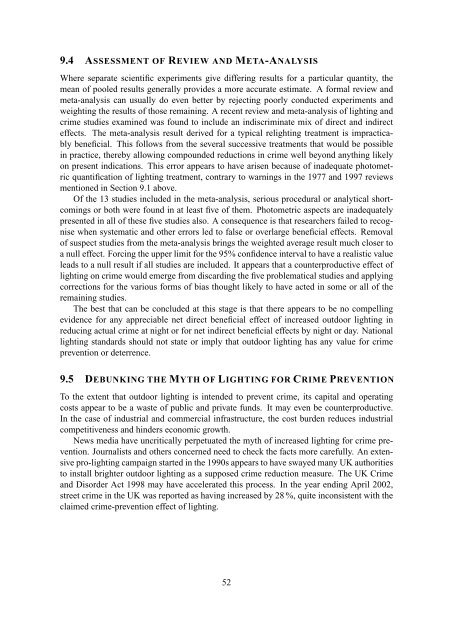outdoor lighting and crime, part 1 - Astronomical Society of Victoria
outdoor lighting and crime, part 1 - Astronomical Society of Victoria
outdoor lighting and crime, part 1 - Astronomical Society of Victoria
Create successful ePaper yourself
Turn your PDF publications into a flip-book with our unique Google optimized e-Paper software.
9.4 ASSESSMENT OF REVIEW AND META-ANALYSIS<br />
Where separate scientific experiments give differing results for a <strong>part</strong>icular quantity, the<br />
mean <strong>of</strong> pooled results generally provides a more accurate estimate. A formal review <strong>and</strong><br />
meta-analysis can usually do even better by rejecting poorly conducted experiments <strong>and</strong><br />
weighting the results <strong>of</strong> those remaining. A recent review <strong>and</strong> meta-analysis <strong>of</strong> <strong>lighting</strong> <strong>and</strong><br />
<strong>crime</strong> studies examined was found to include an indiscriminate mix <strong>of</strong> direct <strong>and</strong> indirect<br />
effects. The meta-analysis result derived for a typical re<strong>lighting</strong> treatment is impracticably<br />
beneficial. This follows from the several successive treatments that would be possible<br />
in practice, thereby allowing compounded reductions in <strong>crime</strong> well beyond anything likely<br />
on present indications. This error appears to have arisen because <strong>of</strong> inadequate photometric<br />
quantification <strong>of</strong> <strong>lighting</strong> treatment, contrary to warnings in the 1977 <strong>and</strong> 1997 reviews<br />
mentioned in Section 9.1 above.<br />
Of the 13 studies included in the meta-analysis, serious procedural or analytical shortcomings<br />
or both were found in at least five <strong>of</strong> them. Photometric aspects are inadequately<br />
presented in all <strong>of</strong> these five studies also. A consequence is that researchers failed to recognise<br />
when systematic <strong>and</strong> other errors led to false or overlarge beneficial effects. Removal<br />
<strong>of</strong> suspect studies from the meta-analysis brings the weighted average result much closer to<br />
a null effect. Forcing the upper limit for the 95% confidence interval to have a realistic value<br />
leads to a null result if all studies are included. It appears that a counterproductive effect <strong>of</strong><br />
<strong>lighting</strong> on <strong>crime</strong> would emerge from discarding the five problematical studies <strong>and</strong> applying<br />
corrections for the various forms <strong>of</strong> bias thought likely to have acted in some or all <strong>of</strong> the<br />
remaining studies.<br />
The best that can be concluded at this stage is that there appears to be no compelling<br />
evidence for any appreciable net direct beneficial effect <strong>of</strong> increased <strong>outdoor</strong> <strong>lighting</strong> in<br />
reducing actual <strong>crime</strong> at night or for net indirect beneficial effects by night or day. National<br />
<strong>lighting</strong> st<strong>and</strong>ards should not state or imply that <strong>outdoor</strong> <strong>lighting</strong> has any value for <strong>crime</strong><br />
prevention or deterrence.<br />
9.5 DEBUNKING THE MYTH OF LIGHTING FOR CRIME PREVENTION<br />
To the extent that <strong>outdoor</strong> <strong>lighting</strong> is intended to prevent <strong>crime</strong>, its capital <strong>and</strong> operating<br />
costs appear to be a waste <strong>of</strong> public <strong>and</strong> private funds. It may even be counterproductive.<br />
In the case <strong>of</strong> industrial <strong>and</strong> commercial infrastructure, the cost burden reduces industrial<br />
competitiveness <strong>and</strong> hinders economic growth.<br />
News media have uncritically perpetuated the myth <strong>of</strong> increased <strong>lighting</strong> for <strong>crime</strong> prevention.<br />
Journalists <strong>and</strong> others concerned need to check the facts more carefully. An extensive<br />
pro-<strong>lighting</strong> campaign started in the 1990s appears to have swayed many UK authorities<br />
to install brighter <strong>outdoor</strong> <strong>lighting</strong> as a supposed <strong>crime</strong> reduction measure. The UK Crime<br />
<strong>and</strong> Disorder Act 1998 may have accelerated this process. In the year ending April 2002,<br />
street <strong>crime</strong> in the UK was reported as having increased by 28 %, quite inconsistent with the<br />
claimed <strong>crime</strong>-prevention effect <strong>of</strong> <strong>lighting</strong>.<br />
52
















